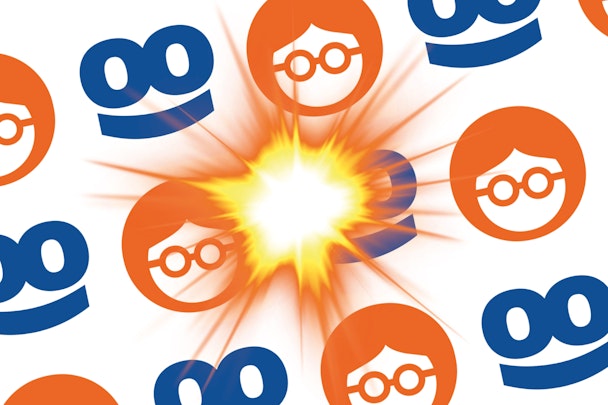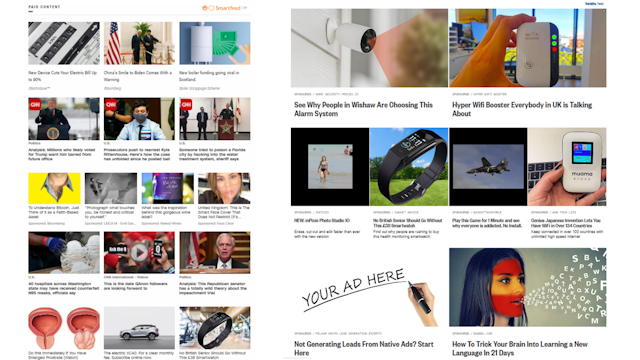
Advertisement

Not so chummy anymore: after merger didn't click, what’s next for Taboola and Outbrain
Content recommendation engines Outbrain and Taboola were once primed for a $2bn-valued mega-merger that they said would rival the duopoly and save the open web. Relations between the Israeli startups soured, however, and the deal fell through. The Drum catches the CEOs of both to find out how they plan to innovate their tech, fund publishers and change some marketers’ minds. The ‘chumbox’ cold war continues.
Outbrain and Taboola, founded in 2006 and 2007, plug into publishers’ websites to direct audiences to internal and/or external content. Publishers secure guaranteed income for external clicks. Advertisers reach engaged news audiences. And people get content that interests them. Ideally.
These businesses were built on clicks. Advertisers often saw the best results bringing readers to advertorials with clickbait, hyperbolic headlines and visceral/engaging images. Recently, both have had to clean up the networks and enforce their rules. Brand safety and misinformation are hot topics now after all.
And after a very public “divorce” that played out late in 2020, The Drum looks at what the future holds for both.
Below a CNN article, Outbrain’s Smartfeed mixes relevant internal links with external ones in an unending stream. The highest bidders are an energy brand and a boiler scheme. Following them is a feature from Bloomberg, a camera brand, D2C wine, acne solution, more CNN links and then an illustration of a swollen prostate and a man’s foot. That escalated quickly.
On NBC News’ Taboola Feed, meanwhile, there’s more room to breathe. A poorly localized advertorial for security cameras sets the tone. Tech and software follow. These must work with this audience. Internal links are below. On Business Insider, Taboola has plugged in four sponsored links at the foot of each article. All big external links. There’s a ‘must-have’ pillowcase, a property competition from Omaze, two financial companies (legit).
There are no Ponzi schemes, Russian brides or fake news on any of the feeds. Some real brands were visible. These feeds are fairly typical of what to expect.

Historically, ’chumbox’ ads were forged by A/B testing. Survival of the clickiest inspired some slimy engagement tricks that the media hosting the feeds implemented too. But moderation has been stepped up, claims a source who buys from both companies.
Marketers use these boxes for sales, lead generation, data capture, building email lists. Even other publishers will push their branded content. But can the tools do more? Content recommendation did, after all, build empires out of YouTube, Netflix and Spotify.
Taboola has 1,500 staff, combined with Outbrain that would have been around 2,000. With the deal dead, both compete for publisher real-estate. One buyer tells how publishers switch between them like home insurance every two years for the best deal. Furthermore, publishers had been worried that the merger would kill this trick. Competition authorities were studying the merger and rivals at Verizon Media and Revcontent would have been watching with interest.
As is, Taboola says it reaches 516 million daily active users for 13,000 advertisers. Adam Singolda, the chief executive and founder of Taboola, says the agreed fee “didn’t make sense” after he got a look under the hood of Outbrain.
He tells The Drum that the merger was ”the right thing to try, but it did not happen”. We are speaking a few weeks after Taboola went public via a special purpose acquisition company. “I always wanted to take the public and that would have happened either way.” This new deal is expected to close in the second quarter.
For now, tiding publishers through a tough time remains the priority. “We have a win/win approach of working with publishers – we only succeed if publishers succeed. Our future is very aligned to that.”
Asked about why the industry has this clickbait, chumbox reputation, he tells us he doesn’t have a good answer. ”I just focus on doing the right thing.” This involves a moderation team of 50, who between them review roughly half a million pages a week. He doesn’t think AI can do it. “Fake news and hate, we do not want to be in that business. We have very detailed policies.”
As for the quality of the ads, Singolda points out: “Some people like them. And some people don’t. The perfect ad is something that the user appreciates and uses.” On clickbait, advertisers using a misleading thumbnail or headline will simply see the user not engage with the advertorial. “It would be a mistake to do that.”
Instead, if you want to flourish on Taboola, he points to the example of headphone startup Flare Audio. Priced out of search and social by established players, its founders’ story did well on Taboola and sold “thousands“.
Going forward, it is developing publisher revenue, video and e-commerce products, and is looking at ways of distributing news outside of the web browser – particularly in CTV. He urges marketers to give the platform a try to “diversify from the walled garden and see their money spent with journalism”.
Outbrain’s co-founder and co-chief executive Yaron Galai is similarly reluctant to discuss the merger. Instead, he sums up his year and tells how, as the lockdown hit and ad spend fell, Outbrain didn’t follow Taboola’s lead in pausing its revenue guarantees for publishers and moving to revenue share deals. Instead, it absorbed the financial hit in the name of trust and reliability. Remember, digital media publishers cut tens of thousands of staff last year.
Galai says: “Even though we saw an initial drop in revenue, we stuck to our commitments with all publishers. We didn’t use Covid-19 as an excuse to renegotiate anything, which other companies did.”
So now Outbrain has roughly 1 billion monthly unique users and 20,000-ish advertisers. Galai compares this scale with Facebook, but acknowledges Outbrain does not have the social giant’s 10m advertisers. He wants more and says the product works for brand awareness as well as it does performance marketing. Slim SME teams can immediately show an ROI.
But Galai is more open about talking about the ’chum box’ perception challenge. He says Outbrain was the first in the space to develop public content guidelines. “We actually do our best to enforce them – it’s not some lip service that we forget to enforce for many years.”
He also takes credit for identifying fake news (or what he has been calling fake content) back in 2010. It banned this content outright in 2014 (seven years into its existence, but years before we were talking about fake news on social media). He says this reduced revenue by 25% overnight, meaning that within the past decade there had been a time when a quarter of Outbrain’s revenue came from fake stories. It takes time to recover from this perception, even if Outbrain did the right thing to its detriment.
Another reason it has a bad rap, he says, is that these ads are more noticeable. Some are shocking and visceral. Some contrast with the quality news content they neighbor. Bad Google Search ads (text-only) or weird social spots don’t get as tough a ride. Maybe they’re more integrated. Maybe we’re more acclimatized to them. Maybe they’re more forgettable.
Galai acknowledges that the open stream of Outbrain isn’t for everyone. Filling trusted news publishers’ sites with the most hyperbolic, clickbaity content from around the web could cause harm to trust and perception. But he says publishers are in full control of the revenue v quality floodgates, not Outbrain.
“We decide who we do business with, sure, but in terms of clickbait, it’s only up to publishers. Some really care about the user experience in the perceived quality. They’ll be very strict. Others want the shorter-term clicks and revenues. It is the publishers that make these discussions.
“If you were to listen in to my discussions with publishers, you would think I’m the publisher urging for higher quality ads and a better user experience.”
It’s a sign of how revenue-starved publishers are. Its a hunger driving a pivot to paywalls and reader revenue. But where does that leave content recommendation?
Galai believes Outbrain has a place here. He sees some environments closing up shop and contracting. “Open web audiences don’t necessarily align with subscription strategies,” he admits.
For publishers that implement metered paywalls, recommendation could be a big part of driving internal engagement and making a subscription seem like better value for money. Cross-promotion of audiences (such as CNN into Bloomberg) could see paying audiences shared at a greater scale. Bloomberg is using these tools to sell its subscriptions directly too.
“I think this pivot will bring back the accountability that publishers that have lost. When none of your audience is a paying customer, you lose your accountability.”
Looking forward, Galai is enthused by its click-to-play video product.
GroupM media thought leader Brian Wieser says these products are not “top of mind” for large brands. He thinks they could oversaturate web pages with ads and degrade brand perception of the publisher and the effectiveness of the display ads too.
To attract big brands, these companies need to tackle “their associations with hyperbolic content… it’s going to be hard to persuade brands that are trying to build long-term value, and that borrow the brand equity of the content around which they run their ads, to get excited.
“Brands convey over decades what they stand for and that they will be around forever… and that feeling depends on being trustworthy and being in a trusted environment.”
This fear limits the potential pool of clients. Wieser admits this doesn’t mean the services are not effective or don’t operate in thriving niches.
Speaking on behalf of media titles, digital media consultant Jack Marshall says publishers aren’t in a position to turn away the reliable revenue. Revenue guarantees (should) offer stability as the wider market fluctuates.
They can clean up even further but, he says, “constricting or controlling demand will likely result in less revenue for the CREs and, ultimately, the publishers they work with”.
And with the pivot to paid, are paying users going to want to see streams of content from the open web clutter their experience. It is something publishers are seriously considering.